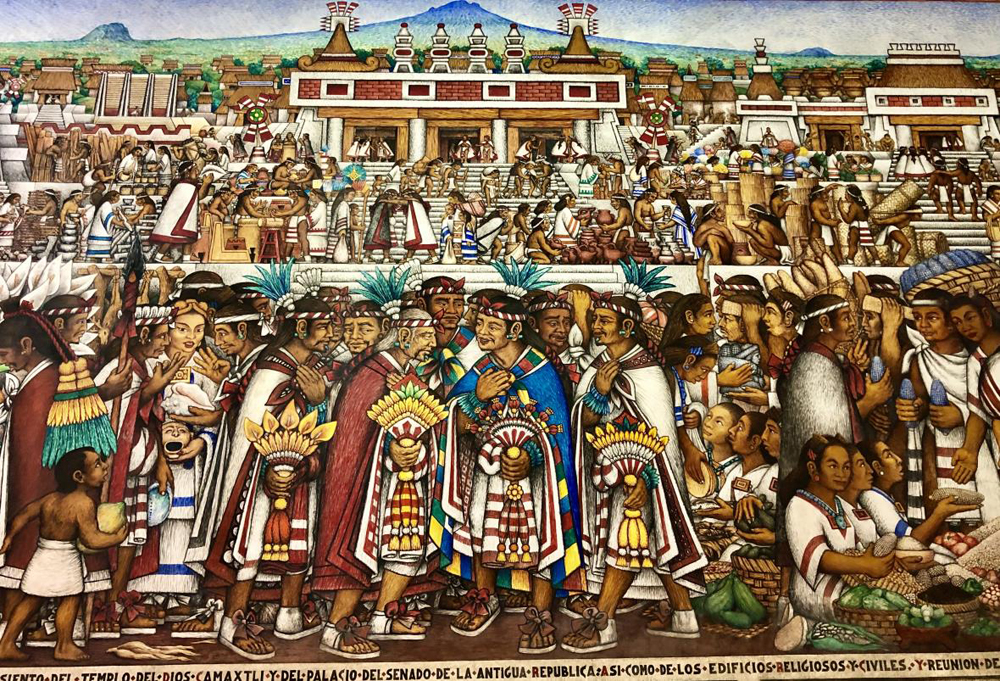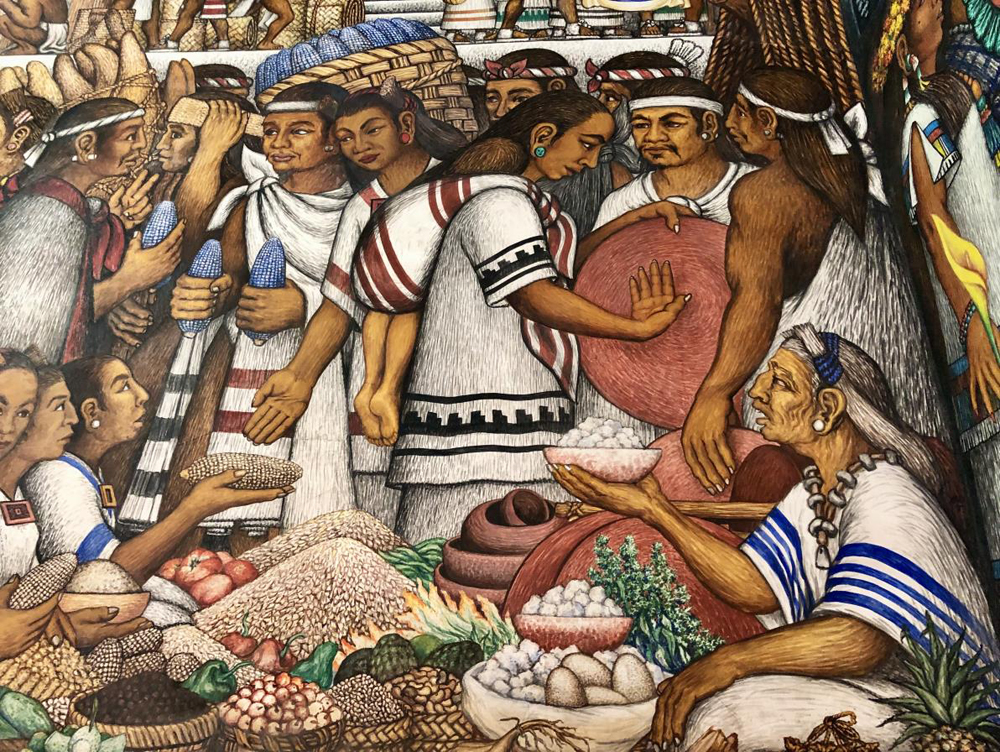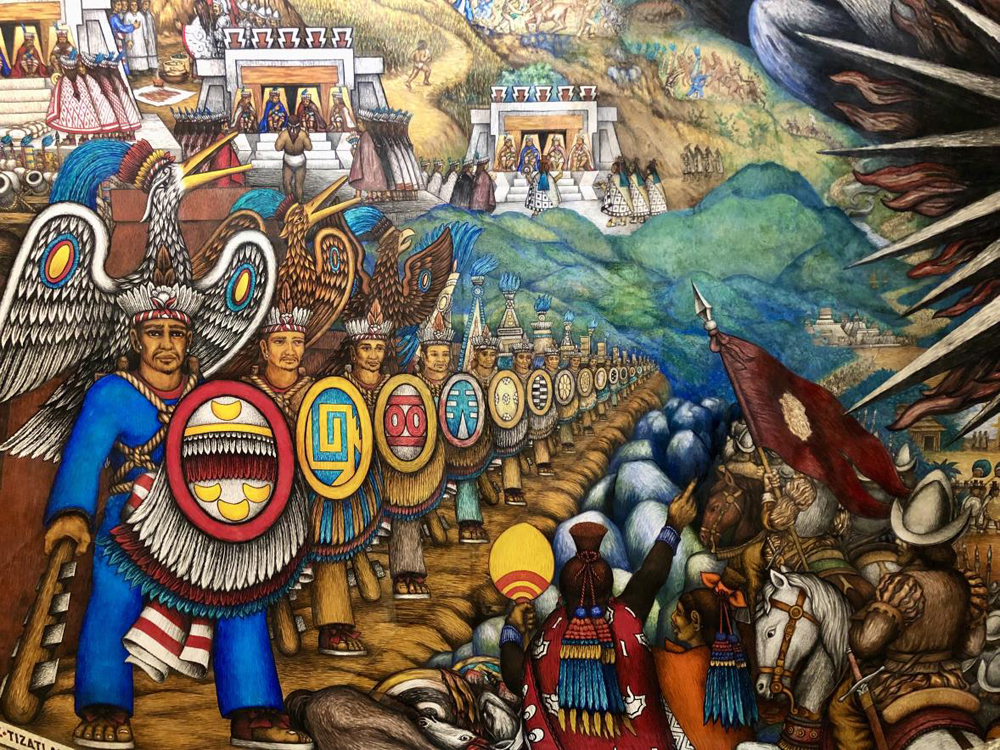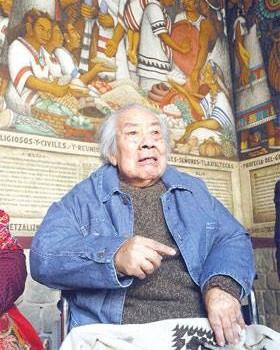 Español
Español
April 21, 2024
by Patricia Argüello Melgar
Entering the Palacio de Gobierno, the building housing the government of the State of Tlaxcala, finds me standing in front of a depiction of great events in the history of Mexico. The beauty of the mural comes out to meet, embrace and dazzle me for being so genuine, so beautifully captured by the genius of the brush and paintbrush of Master Desiderio Hernández Xochitiotzin. The mural is called: "History of Tlaxcala and its contribution to Mexican culture."
I go through the mural, section by section, beginning with the pilgrimage, the departure of the 13 tribes. The Indians reflect the dignity and the old power of their lordships. The colors of their blankets and feathers are so real that we are immediately transported to that time now so distant.
The encounter of Hernán Cortés with Xicoténcatl marks the beginning of duality reflected in the unity that we, the Mexican people, are today. Near the central part there is an indigenous woman carrying her son, the child looks at us with a love so deep that it barely fits in his black eyes.
I also understand the grand presence of the two volcanoes Popocatepetl and Iztaccihuatl. They seem like two guardians, who vigilantly have witnessed our inevitable encounters with pain, domination, subjugation; wars, but also songs, rites, births and deaths. Encountering the mural, with its depiction of our history, overwhelms me and increases my admiration for the men and women who have preceded us, who with great dignity have forged our Nation.

The experience, up close, of genius and talent so masterfully combined, makes me want to get to know the artist, he who captured on those walls the greatness of the indigenous groups; flowery wars, conquest until the independence of Mexico; with an objectivity and serenity without a hint of any kind of Manichaeism; and the want becomes a necessity for me. In a second visit to Tlaxcala my need is met; I have the good fortune to be received in the home of Maestro Desiderio Hernández Xochitiotzin.
While waiting for him in his living room, I discover some pencil sketches of indigenous men and women. Suddenly, a short, 83-year-old man with a profound gaze greets me cordially and tells me: "I am at your service". His humility surprises me, and I only manage to say: "Master, I just want to meet the author of that wonderful mural that adorns the Government Palace of Tlaxcala."
We began a friendly, collegial dialogue, in which his concepts reflect a great simplicity and wisdom. He confesses: "The best thing about my work is that it is alive. People like it. It moves them and sometimes confronts them, because we don't quite understand who we are or why we are. Sometimes I like to go to the Palace and listen to the visitors' comments."
I tell him that he has managed to merge, in a very talented way, history with the plastic arts; to which he responds that he has dedicated himself to study and review the history of Mexico for more than 50 years, doing it directly from the codices, from the sacred books of the different indigenous groups that preceded us. He declares that he does not agree with the way in which the "official history" is presented, with its many gaps, many exceptions and many omissions.

He questions "What is culture? The word comes from 'cultivation.' Culture is far from formal education. Culture is cultivated through centuries. Then, tradition is the remains, what is left. The ofrenda [offering] must be alive. Let us not gather paper and plastic in nonsense. I believe in fraternal coexistence with the ancestors. I also believe that dogs accompany the dead to the afterlife."
He reveals that each section of the mural, more than 450 square meters, is backed by meticulous historical research. He confesses: "When the masons clean and prepare the bare walls, and I begin the first brushstrokes, I ignore the expressions of the characters. Then, when my goal is to capture just the shape of the faces. Then I have only one option, to go walking through villages near the center of Mexico studying and internalizing the physiognomies of the indigenous people. However, when I am already working, painting in oil on the walls, then the facial features come out by themselves, as if painted by them. Then I discover a great force that inspires and guides me".
He asserts that it is necessary to rescue the collective memory of the people, their wisdom, their religious concepts, so broad and deep. We have deep artisan roots, there was a lot of artistic talent in the indigenous groups, they were not afraid of color and figures. He asks: "Who is Mexico? We find indigenous groups confronting each other, the conquest, Philip II, the war with the United States, Santa Anna, Juarez, the Independence, the Revolution, so many historical milestones. What is left for us? What we have left of Mexico is the fundamental part of that integration: spirituality. That's why I think the artist must integrate with his spiritual essence."
His narration is impregnated with the astonishing. He confesses: "When my first son was born, in his first breaths, my astonishment was enormous. I realized that we, his parents, had only been the means and not his creators. The Miracle of Life. So it also was when I have finished stages of the mural 'Historia de Tlaxcala y su aportación a lo mexicano.' I thank God for having finished despite so many problems and obstacles, some of them financial. My joy is enormous when I hear comments from visitors about the mural, while I stand there anonymously. Then I say, 'The work works. It is alive. That is the silent applause".

Summing things up Master Desiderio Hernández Xochitiotzin reflects:
